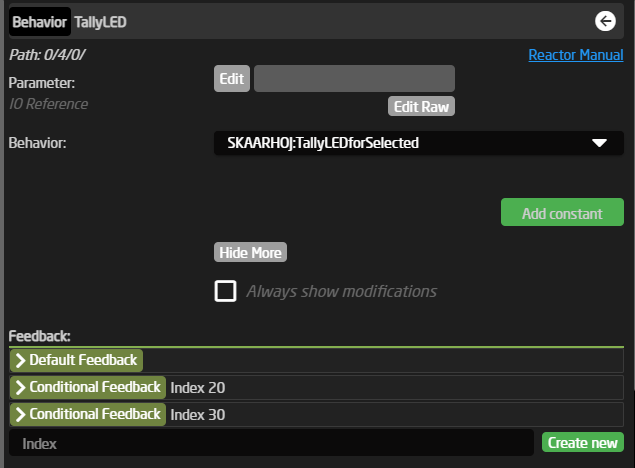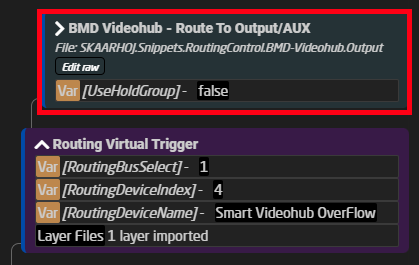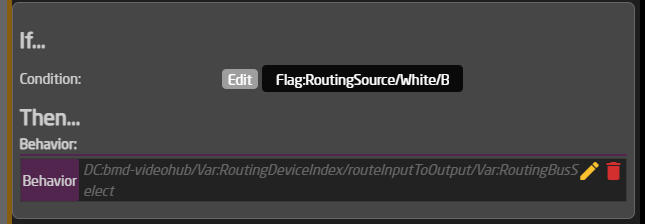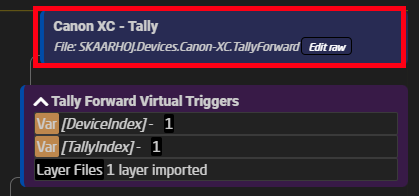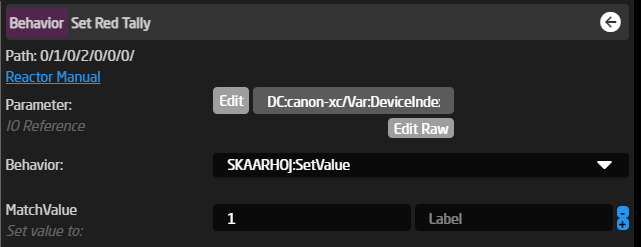Understanding Flags
Inside reactor we have support for setting flags true or falls. These flags are based around how TSL works to some extend and provides a list of truefalls states with 4 "bits" pr index.
Flags in reactor consists of 4 bits pr index, that can be set true or false individually, each of these flag bits can be used for different things but you will mainly see them used for providing tally and routing support in configs as they are a great way to store the intermediate state that comes in from a GPI pin or from a device like an ATEM switcher. Then use the stored state to send the Tally to the cameras
The 4 "colors/bits" main use cases in the default configs for each color are:
|
Red |
Mainly used for Program Tally |
| Green | Mainly used for Preview Tally |
| Blue | Not widely used in default configs yet |
| White | Mainly Used for storeing what camera to Route on a mixer/videohub |
These are not limited to this use case, but this is the current convention we use internally.
Define flag groups and sync them up
When you use flags you will need to add them to your project as "Flaggroups" with a name and an Index.
One Important note is that ANY config that you have loaded in the project that uses the same Goup ID will be synced even if you have different names for them. This means that you can "sync" up tally or routing between 2 or more controllers running in the same reactor just by changing the flaggroup ID for "Tally" to be the same on both panels. this is also a very simple way to add a GPIO or Tally box to an existing system/setup.
This also brings the problem of if you happen to set your Routing group to the same ID as your Tally group, funny stuff might happen. But since we are using different Bit's for it. you should be fine, and not risk having "crosstalk" between them. but for simplicity we have made sure to make them on different group ID's in all default configs.
Here is an example form a PTZ Extreme about how these groups are defined on Index 10 and 11:

How to set a flag
The simplest way to set a flag is to use the normal "SKAARHOJ:HoldDown" behavior on a button/GPI pin or in a virtual trigger where you might use the tally status reported by your switcher.
When setting flags we are looking at an IORefrence structure that looks like this:
Flag:Tally/Red/Var:TallyIndex/
So to break it down we have:
Flag:[Group Name]/[Color]/[Index]
Often you will see us use a variable for the index, as in most cases we use in together with a constant set where the user can fill in what routing input or tally index it should follow. so for a mixer setup the tally index would coralate with what camera number it is on the actual mixer.
Some examples of this in use
Here is a couple of examples of how these setups look, they are posted here in json format as it's the simplest way to get a condensed look at the setup:
From and RCP using the GPI input to set the red tally flag on the selected camera:
{
"ParentID": "SKAARHOJ:HoldDown",
"IOReference": {
"Raw": "Flag:Tally/Red/Var:TallyIndex"
}
}And Here for the preview button (same as pressing the joystick) on the Same RCP, that sets a Routing flag instead:
{
"ParentID": "SKAARHOJ:HoldDown",
"IOReference": {
"Raw": "Flag:RoutingSource/White/Var:RouteIndex"
},
"FeedbackDefault": {
"DisplayText": {
"Title": "Preview"
}
}
}A more extreme setup of using a Virtual trigger for setting the tally flags with tally status from an ATEM mixer:
This is the file you load when you select a tally device in the constantset:
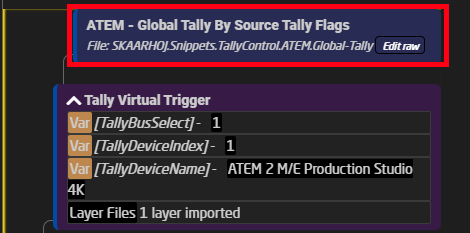
Inside it has two Virtual triggers that sets the Program and Preview Tally and they do the same thing where they read the state of the tally parameter on the ATEM and stores it into the flags on either the colour red or green, depending on if it's the program or preview tigger.
Full code for the ATEM Tally snippet:
{
"Name": "ATEM - Global Tally By Source Tally Flags",
"MetaData": {
"DeviceCoresInside": {
"bmd-atem": []
},
"Priority": 150
},
"VirtualTriggers": [
{
"Name": "Set Program Tally",
"ConstantSetReference": "CameraSelector",
"Mode": "Binary",
"BinaryActiveIf": "DC:bmd-atem/Var:TallyDeviceIndex/TallyBySourceTallyFlags/Behavior:Const:TallyIndex/1 == true",
"AnalogIOref": {},
"HoldGroupFinalValue": {},
"Behavior": {
"ParentID": "SKAARHOJ:HoldDown",
"IOReference": {
"Raw": "Flag:Tally/Red/Behavior:Const:TallyIndex"
}
}
},
{
"Name": "Set Preview Tally",
"ConstantSetReference": "CameraSelector",
"Mode": "Binary",
"BinaryActiveIf": "DC:bmd-atem/Var:TallyDeviceIndex/TallyBySourceTallyFlags/Behavior:Const:TallyIndex/2 == true",
"AnalogIOref": {},
"HoldGroupFinalValue": {},
"Behavior": {
"ParentID": "SKAARHOJ:HoldDown",
"IOReference": {
"Raw": "Flag:Tally/Green/Behavior:Const:TallyIndex"
}
}
}
]
}How to read a flag
Reading a flag is very similar to setting a flag, but now we look at the feedback value of it instead and compare it against if it's true or false.
The simplest way to read a flag is to use the "SKAARHOJ:Output" behavior on a LED or GPO pin or in a virtual trigger where you might use the tally status reported by your switcher.
Some examples of this in use
Here is a couple of examples of how these setups look, they are posted here in json format as it's the simplest way to get a condensed look at the setup:
Fist the simplest way of reading it is for a GPO pin on an RCP for providing routing support externaly:
{
"ParentID": "SKAARHOJ:Output",
"IOReference": {
"Raw": "Flag:RoutingSource/White/Var:RouteIndex"
}
}Another usecase if for a Tally LED on a bluepill or RCP where you will see a setup like this, where it reads both the Red and Green Tally bit:
{
"Name": "Tally LED - Selected",
"Description": "Show tally for selected tally index (in TallyIndex variable, using Tally Flag group)",
"IOReference": {},
"FeedbackDefault": {
"Intensity": "Dimmed"
},
"FeedbackConditional": {
"20": {
"ActiveIf": "Flag:Tally/Green/Var:TallyIndex == true",
"Color": {
"ColorCode": "GREEN"
},
"Intensity": "On"
},
"30": {
"ActiveIf": "Flag:Tally/Red/Var:TallyIndex == true",
"Color": {
"ColorCode": "RED"
},
"Intensity": "On"
}
}
}The last two main usecasses that we will look at is reading a flag and then sending some command to a BMD Video hub for providing Routing control, this is using virtual triggers:
This is the file you load when you select a routing device in the constantset:
Inside it has on Virtual triggers that reads the stored Routing flag and sends the routing selected and sends it of to the parameter on the Videohub.
{
"Name": "Basic V-Trigger",
"ActiveIf": "Var:UseHoldGroup:Current == false",
"VirtualTriggers": [
{
"Name": "Set Routing Source",
"ConstantSetReference": "CameraSelector",
"Mode": "Binary",
"BinaryActiveIf": "Flag:RoutingSource/White/Behavior:Const:RouteIndex == true",
"AnalogIOref": {},
"HoldGroupFinalValue": {},
"Behavior": {
"ParentID": "SKAARHOJ:SetValue",
"IOReference": {
"Raw": "DC:bmd-videohub/Var:RoutingDeviceIndex/routeInputToOutput/Var:RoutingBusSelect"
},
"EventHandlers": {
"trigger": {
"BinarySetValues": {
"Raw": "Behavior:Const:RouteIndex"
},
"IOReference": {}
}
}
}
}
]
}The last main usecase to show of here is doing the same as for routing but for forwarding the tally states directly to any camera connected. We will look at the setup for the Canon PTZ cameras in this example:
This example is taken from a ETH-GPIO Link box, but it's the exact same code used on all PTZ controllers.
Inside the Camera Selector you will have a field for the "Tally Forward Config", this should auto fill for you and look something like this:

This will then load up like this inside the config, in something that should look familiar by now, as it's the same setup as for the tally and routing setups mentioned above.
The big difference here is that this setup will very a lot depending on how the cameras handle tally, but one thing they will all have in common is that they have a trigger for disabeling tally altogether, and that they all use the same flags, red and green for the tally feedback. On the Canon PTZ's you will see a total of 4 Virtual triggers. We will only look at the "Set Red" trigger.
{
"Name": "Set Red Tally",
"ActiveIf": "Var:TallyToCam == true",
"Mode": "Binary",
"BinaryActiveIf": "Flag:Tally/Red/Var:TallyIndex == true",
"AnalogIOref": {},
"HoldGroupFinalValue": {},
"Behavior": {
"ParentID": "SKAARHOJ:SetValue",
"Constants": {
"MatchValue": {
"Values": [
"1"
]
}
},
"IOReference": {
"Raw": "DC:canon-xc/Var:DeviceIndex/f.tally.mode"
}
}
}As seen above, it's basically the same thing the difference is only that here we have a "MatchValue" to select that it's the program we want to set on the Canon PTZ, if we want to swap the colours on the PTZ, then it's just a matter of changing this from a 1 to a number 2 and the reverse on the preview trigger. this is because of the options avaliable on the camera, to look more at these option please refer to the parameter list for the Canon-XC core.
Here is the full JSON for this layer with all 4 virtual triggers, in their current form:
{
"Name": "Canon XC - Tally",
"MetaData": {
"DeviceCoresInside": {
"canon-xc": []
},
"Priority": 100
},
"VirtualTriggers": [
{
"Name": "Disable Tally To Cam",
"Mode": "Binary",
"BinaryActiveIf": "Var:TallyToCam == false",
"AnalogIOref": {},
"HoldGroupFinalValue": {},
"Behavior": {
"ParentID": "SKAARHOJ:SetValue",
"Constants": {
"MatchValue": {
"Values": [
"0"
]
}
},
"IOReference": {
"Raw": "DC:canon-xc/Var:DeviceIndex/f.tally"
}
}
},
{
"Name": "Toggle Tally lamp",
"ActiveIf": "Var:TallyToCam == true",
"Mode": "Binary",
"BinaryActiveIf": "Flag:Tally/Red/Var:TallyIndex == true || Flag:Tally/Green/Var:TallyIndex == true",
"AnalogIOref": {},
"HoldGroupFinalValue": {},
"Behavior": {
"ParentID": "SKAARHOJ:HoldDown",
"IOReference": {
"Raw": "DC:canon-xc/Var:DeviceIndex/f.tally"
}
}
},
{
"Name": "Set Red Tally",
"ActiveIf": "Var:TallyToCam == true",
"Mode": "Binary",
"BinaryActiveIf": "Flag:Tally/Red/Var:TallyIndex == true",
"AnalogIOref": {},
"HoldGroupFinalValue": {},
"Behavior": {
"ParentID": "SKAARHOJ:SetValue",
"Constants": {
"MatchValue": {
"Values": [
"1"
]
}
},
"IOReference": {
"Raw": "DC:canon-xc/Var:DeviceIndex/f.tally.mode"
}
}
},
{
"Name": "Set Green Tally",
"ActiveIf": "Var:TallyToCam == true",
"Mode": "Binary",
"BinaryActiveIf": "Flag:Tally/Green/Var:TallyIndex == true && Flag:Tally/Red/Var:TallyIndex == false",
"AnalogIOref": {},
"HoldGroupFinalValue": {},
"Behavior": {
"ParentID": "SKAARHOJ:SetValue",
"Constants": {
"MatchValue": {
"Values": [
"0"
]
}
},
"IOReference": {
"Raw": "DC:canon-xc/Var:DeviceIndex/f.tally.mode"
}
}
}
]
}







